MONDAY'S SCRIPT TIP:
2 PLUS 2
"The job of the director is to suggest two plus two. Let the viewer say four," Ernst Lubitsch

That is the job of the screenwriter as well. When you spoon feed information to the audience they know it and feel as if you are treating them as idiots... and feel as if you are manipulating them. Of course, the writers who spoon feed information are usually don’t have the skills to manipulate the audience. The writer is a magician, and our goal is to manipulate the audience in such a way that we are never caught. That takes skills, and one of those skills is to give the audience the pieces and let them assemble those pieces themselves. The audience feels in control, and guess who is providing the specific pieces of the puzzle to be assembled? The writer! Just like any jigsaw puzzle, no matter who assembles those pieces you end up with the picture on the box... and the person assembling the puzzle thinks that *they* made that picture. So "Some assembly required" is a good thing, and a great thing for a writer to use.
THE COMMUTER (2018) reteams Liam Neeson and director Jaume Collet-Serra (screenplay by Byron Willinger & Philip de Blasi and Ryan Engle) in the story of ex-Police Detective Michael MacCauley (Neeson) who quit the force for a peaceful life in the suburbs as an Insurance Salesman - what could be less exciting than that? He commutes to New York City every business day on the train, with mostly the same passengers who are also commuting to their jobs.
Now, there are a bunch of ways that we might have given the audience this information, but which one would make the audience *feel* those ten years of commuting every day?
The story begins with a montage of those ten years as Michael is driven to the station by his wife Karen (Elizabeth McGovern) kisses her goodbye and boards the train. Again and again and again. Along the way, things change slightly. Karen is pregnant. Now he has a son, Danny (Dean-Charles Chapman) and we watch the son grow up. The routine is the same, but details change - and that shows us time passing. Michael and Karen get older, too - though less obvious than a kid growing up, but Neeson plays his age in this film. His hair is turning gray. The viewer sees the passage of ten years and experiences the relentless same-ness of the commute. Rain or shine, through ten years, it never changes.
In this montage we are also introduced to some of the regular faces on the train - including Walt (Jonathan Banks) who will figure into the story later. Actually, all of the regulars will figure into the story later - which is another great thing that this montage does - sets up our supporting cast.
INCITING INCIDENT

Michael’s happy-but-dull routine hits a series of snags. First up: his boss tells him that despite his great work, due to the economy he is being let go - downsized. It’s not his fault, there’s nothing he can do to change things, he’s just out a job.
Now, the audience has seen his wife and son - they have known them for ten years! How do you think this even will make the viewer feel? They add up the family responsibilities and a middle aged man losing his job and think: How is he going to survive? And the audience feels sympathy for him and cares about him.
Michael needs a drink, and goes to his old haunt - a cop bar - where he bumps into his old partner Murphy (Patrick Wilson) and his old enemy on the force, Hawthorne (Sam Neill) who has since been promoted to Captain. Michael and Murphy have a conversation about his being downsized - and how he has neglected to phone Karen and tell her. He says he is going to tell her in person... but we get the feeling that he’s just stalling. He doesn’t want to tell her at all. This humanizes him.
On the train going home, the audience is the now thinking that Michael’s big problem is telling his wife that he is jobless... and that’s when fellow commuter Walt tells him that a woman has been watching him. This creates a few moments of mystery, until Michael sits down and the woman, Joanna (Vera Farmiga), sits with him. The last time I saw a movie with Vera Farmiga and a commuter train, the train exploded every 8 minutes - so this probably won’t end well. Joanna *knows who he is* and * knows everything about him* - creepy! She tells him that he has a particular set of skills that can help her find someone on the train named “Prynne” who is *not* a regular - and there is $250,000 in cash hidden in the train car’s bathroom - a down payment. More if he finds "Prynne" before the Cold Spring Station where Prynne is supposed to get off.
This is a great inciting incident because it is a hook and a mystery - the audience has no idea what this is all about. But we know with that kind of money involved it’s not legal. And we know that Michael is out a job and needs money. What will he do?
2 PLUS 2

Michael goes to the train car’s bathroom, and when he closes the door the light and a fan go on automatically. The fan is at floor level and has a piece of ribbon tied to each side of the grate - but the ribbon is only fluttering on one side... and barely, This place must smell terrible. Michael does a search of the bathroom for the $250,000... knowing that he isn’t going to find it.
Eventually he gets to that fan grate near the floor, unscrews it... and the reason why the ribbons weren’t fluttering? The $250,000 is blocking the vent. Michael looks at the money - will he take it? Will he be part of this probably illegal task?
Michael screws the grate back into place. He leaves the bathroom, but just before he closes the door we see both ribbons fluttering like crazy on the fan grate.
Nothing blocking the vent anymore.
Without ever saying that he took the money, the audience puts 2 and 2 together and gets 4.
Now we get to the puzzle - who on the train doesn’t belong? First we need to narrow down the suspects, and the clue for that is the Cold Spring Station. Michael consults the map that shows the costs of a ticket for each zone. Cold Spring is Zone 7. The tickets all have the zones punched into them, so now we have narrowed our suspects to those with Zone 7 Tickets.
There is a great shot where the camera shows a Zone 7 ticket and then moves through the punch hole to the passenger’s face. This connects passenger with ticket in a visual way - a director’s thing more than a writer thing, but effective.
Throughout the film, the audience is given clues so that *they* can spot the outsider. The audience can even spot the outsider early on, if they are paying attention - a pair of characters switch seats and this leads Michael to think one character who is a Stock Broker may be the outsider because he’s in a seat with a Zone 7 ticket clipped to the seat. That Broker becomes our prime suspect for a while, when it’s the person that they changed seats with who is the actual outsider.
SOME ASSEMBLY REQUIRED

There are other clues where "some assembly is required" - I love the right handed character who owns a left handed guitar. And there’s a dialogue based clue using the word “noble” which points to why Joanna selected Michael to perform this task... and how she knows so much about him. I also love the “red herring” character - a man that Michael (and the audience) realizes does not belong on this train - an outsider! But not the outsider that he was looking for - an FBI Agent placed on the train to protect that outsider... who is a witness in a Federal trial against a mobster. This trial and the witness was planted in the earlier bar scene with Murphy and Hawthorne. Michael suspects that Hawthorne may be working for the mob and behind Joanna selecting him to find the outsider - and that’s another piece of information that the audience is given the puzzle pieces to and assembles it themselves. The clue that leads Michael to the actual outsider - the mystery witness on their way to the trial to testify - is the name “Prynne”. Again, some assembly required, it’s not the character’s name. It’s a code name. The character is reading "The Scarlet Letter".
This film is a puzzle, and it plays fair - giving the audience all of the pieces necessary to solve it, but it lets them assemble those pieces. Though the film has a couple of silly parts, it manages to treat the audience with respect - and allow them to put the pieces together as Michael does to find the outsider. Heck, if you are paying attention, you can find the outsider before he does. Act Three becomes a disaster movie, with a runaway train crash that brings rescue crews and the police SWAT team to arrest Michael... who now must figure out how he can prove that Hawthorne is behind all of this before the SWAT Team attacks the train car he is in with “Prynne”... so those audience members who aren’t good at adding 2 Plus 2 will still be entertained. The key to a screenplay like this isn’t to dumb it down so that those who can’t add will get it, but to target both the intelligent audience and the not-so-intelligent audience and entertain both groups. Those who miss the clues will be entertained by the fight scenes and train crash.
IF YOU DON’T SHOW IT

Though there are verbal clues like "noble" in the film, most of the 2 Plus 2 elements are visual... because this is a movie. Movies show characters in action. People doing things. A film script is more oriented to showing the puzzle pieces than a stage play, because the audience can see those puzzle pieces. Those little ribbons on the vent would never show up on stage, but film can give them a close up. The hole punches for Zone 7 would never show up in a stage play, either - but we can write a line of action where Michael sees the hole punched in the ticket in a screenplay, and to show the hole the only possible shot is a close up. The camera allows the audience to see things that they could not see on stage, so a screenplay needs to be tailored for that. Focusing on the visual.
Movies are about people doing things and stage plays are often about people talking about things. Though a movie can feature characters talking - the camera is the "story delivery system" in a film, while the actors deliver the story on the stage. Dialogue driven stories make better stage plays - film is a visual medium. It's our job to tell the story visually - to create the character actions that will tell the story and the visual clues that allow the audience to assemble the story.
Dialogue in film is usually used as a counterpoint to the action. People usually say one thing and do something entirely different. If a character is afraid, they usually claim that they aren't scared, using false bravado to hide their terror. It's our job to show they are afraid even when they say they aren't. To do that we need to find an action that shows they are afraid, even if they say they aren't. We think that Michael isn’t going to take the $250,000 - we know that he doesn’t want to, that he knows this is something illegal that will probably put him and his family in danger. We can show that... and then show the two fluttering ribbons and tell the audience that despite knowing this will cause him trouble, he took the money.
MORE ADDITION

In John & Jim Thomas, Zak Penn and David Veloz's BEHIND ENEMY LINES (2001) Owen Wilson plays a US Navy pilot on a routine recon mission over Bosnia who is shot down behind enemy lines after photographing Serb soldiers burying murdered civilians in mass graves. The Serbs send a sniper (known only as "Tracker") after him. In one scene Wilson is running like hell to escape the Tracker, stops a truck on a nearby road and hops in. Wilson zooms away in the truck at 50mph, and by the time the Tracker makes it to the road there is no trace of Wilson. But the Tracker is smart and relentless, and is soon back on Wilson's trail. How do we know this? The story gives the audience the pieces and allows them to assemble them..
The Tracker walks down the road until he sees skid marks. Touches them, and his fingers come away with fresh rubber granules. The skid marks start from the South and end North - now he knows the direction the vehicle was moving. A road sign gives us the name of the next town, the Tracker smiles. Without a word of dialogue we know that the Tracker is back on Wilson's trail. No matter what country you live in, no matter what language you speak, you understand what has happened. This is not a fight scene or a chase scene or an action scene, it's a scene that shows a character *thinking* through a problem and finding a solution. The actions how the thought process step-by-step, and allow the audience to put those puzzle pieces together. Instead of some treating the audience like idiots, this scene gives them the pieces and allows them to add them up along with the Tracker.
Later in the film, Wilson sees a familiar landmark and realizes he has run in a circle and is now back where he started. He doesn't say "Hey, this is where I started out!", we see Wilson noting the angel statue from the earlier scene, then begin looking for other landmarks... spotting them as well. The audience spots them, too - they were carefully set up in the earlier scene so that when the audience sees them in this scene they will put two and two together and not only think what Wilson character is thinking, they will feel what he is feeling, too. Instead of using dialogue and giving us the information second hand, by putting us in Wilson's shoes the audience assembles the information just as Wilson does and they experience the story first hand.
EQUALS FOUR

That's one of the major benefits of give the audience the pieces of the puzzle and allowing them to put them together - instead of hearing about what happened, they EXPERIENCE things happening. When the Tracker figured out where Wilson went, so did the audience! That scene takes us inside the Tracker's mind. When Michael in THE COMMUTER looks at the train map to find out what zone Cold Spring Station is located in, and then looks at the train tickets for ones punched with Zone 7, the audience is inside his mind, thinking what he is thinking. The writer has given the audience step-by-step pieces to the puzzle of how to narrow the “suspect list” and they follow those visual steps along with Michael. The key is to figure out what the steps are and how to show the audience these pieces of the puzzle so that they can assemble them into larger information. This not only “allows the viewer to say four”, it creates audience identification with the character. The audience is thinking like the character because the writer has given them all of the pieces - but the audience believes the character is *thinking like they do* because the character draws the same conclusions from the information.
Of course, all of this begins with the writer giving the audience that information. Two Plus Two doesn’t work if you don’t give the audience one of the Twos. So take care to make sure that all of the pieces necessary to assemble the information are there - and easy enough to spot that the audience in the cinema doesn’t need a pause button. People love to figure things out for themselves, so instead of spoon feeding them information, allow them to add 2 Plus 2 and feel like geniuses when they come up with 4. But also make sure there’s an epic train derailment for the audience members who failed Math in grade school.
BRAND NEW!
How Do I do That?

101 SCREENWRITING ANSWERS Blue Book!
New to screenwriting? You probably have questions! How do I get an Agent? How do I write a phone conversation? Do I need a Mentor? What’s does VO and OC and OS mean? What is proper screenplay format? Should I use a pen name? Do I need to movie to Hollywood? What’s the difference between a Producer and a Production Manager, and which should I sell my script to? How do I write a Text Message? Should I Copyright or WGA register my script? Can I Direct or Star? How do I write an Improvised scene? Overcoming Writer’s Block? How do I write a Sex Scene? And many many more! This book has the answers to the 101 Most Asked Questions from new screenwriters! Plus a Glossary of terms so that you can sound like a pro! Everything you need to know to begin writing your screenplay!
All of the answers you need to know, from a working professional screenwriter with 20 produced films and a new movie made for a major streaming service in 2023!
Only $4.99
NO KINDLE REQUIRED! Get the *free* app (any device, except your Mr. Coffee) on the order page on Amazon!
Making Your Own Movie?
WRITE IT: FILM IT BOOK!

Making Your Own Movie?
Writing An Indie Film?
Writing A Low Budget Genre Script To Sell?
Writing A Made For TV Holiday Movie?
You will be writing for BUDGET. On a standard spec screenplay, you don’t have to think about budget, but these types of screenplays writing with budget in mind is critical!
If you are making your own movie, budget, is even more important - and you need to think about budget *before* you write your screenplay... or you will end up with a script that you can’t afford to make (or is a struggle to make). Everyone is making their own films these days, and even if you have done it before there are lots of great techniques in this book to get more money on screen - for less money! You can make a film that looks like it cost millions for pocket change.
344 Pages - ONLY: $7.99!
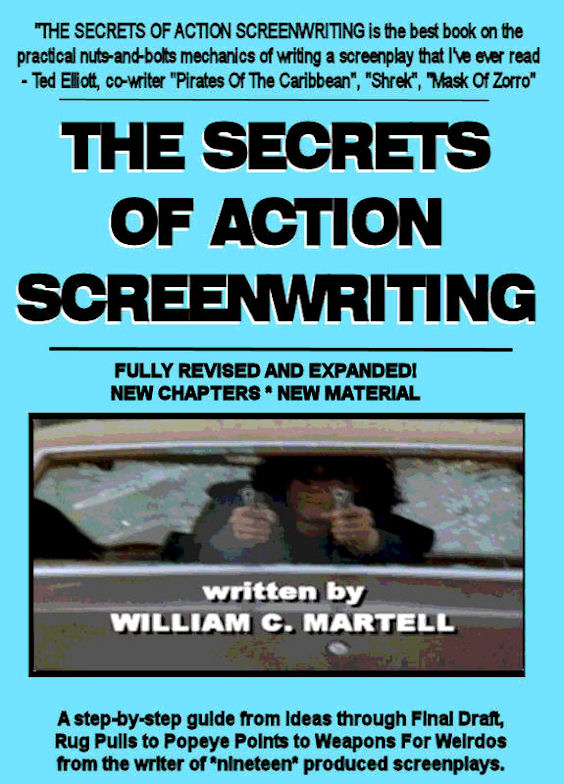
THE BOOK THAT STARTED IT ALL!
*** THE SECRETS OF ACTION SCREENWRITING *** - For Kindle!
*** THE SECRETS OF ACTION SCREENWRITING *** - For Nook!
Why pay $510 for a used version of the 240 page 2000 version that used to retail for $21.95? (check it out!) when
you can get the NEW EXPANDED VERSION - over 500 pages - for just $9.99? New chapters, New examples, New techniques!
"SECRETS OF ACTION SCREENWRITING is the
best book on the practical nuts-and-bolts mechanics of writing a screenplay I've ever read."
- Ted Elliott, co-writer of MASK OF ZORRO, SHREK, PIRATES OF THE CARIBBEAN and the sequels (with Terry Rossio). (ie; 4 of the top 20 Box Office Hits Of ALL TIME.)
Only $9.99 - and no postage!
Tips FAQ

THE BLUE BOOKS!
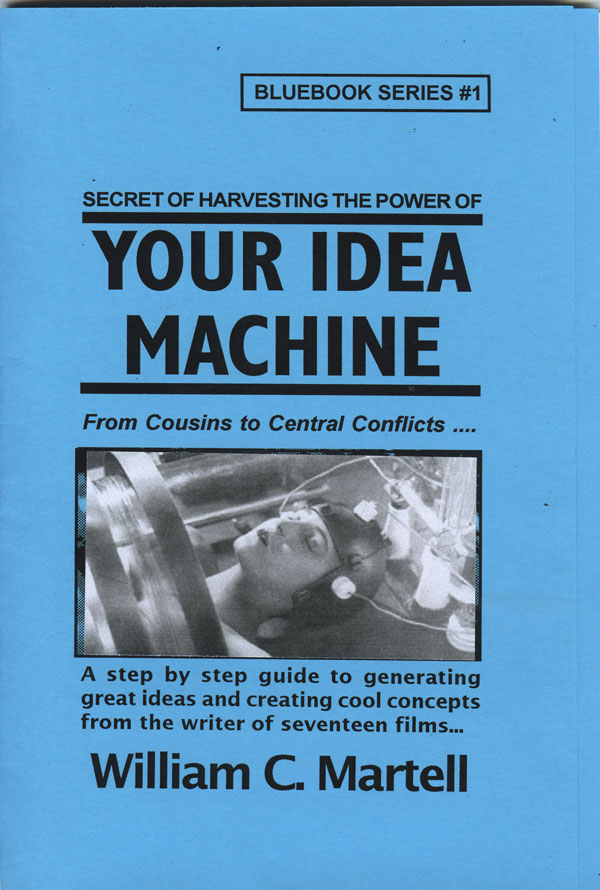
FIND A GREAT IDEA!
*** YOUR IDEA MACHINE ***
Expanded version with more ways to find great ideas! Your screenplay is going to begin with an idea. There are good ideas and bad ideas and commercial ideas and personal ideas. But where do you find ideas in the first place? This handbook explores different methods for finding or generating ideas, and combining those ideas into concepts that sell. The Idea Bank, Fifteen Places To Find Ideas, Good Ideas And Bad Ideas, Ideas From Locations And Elements, Keeping Track Of Your Ideas, Idea Theft - What Can You Do? Weird Ways To Connect Ideas, Combing Ideas To Create Concepts, High Concepts - What Are They? Creating The Killer Concept, Substitution - Lion Tamers & Hitmen, Creating Blockbuster Concepts, Magnification And The Matrix, Conflict Within Concept, Concepts With Visual Conflict, Avoiding Episodic Concepts, much more! Print version is 48 pages, Kindle version is over 175 pages!
Only $4.99 - Kindle Version
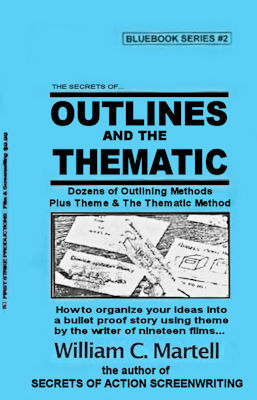
FIGURE OUT YOUR STORY!
*** OUTLINES & THE THEMATIC ***
Your story is like a road trip... but where are you going? What's the best route to get there? What are the best sights to see along the way? Just as you plan a vacation instead of just jump in the car and start driving, it's a good idea to plan your story. An artist does sketches before breaking out the oils, so why shouldn't a writer do the same? This Blue Book looks at various outlining methods used by professional screenwriters like Wesley Strick, Paul Schrader, John August, and others... as well as a guest chapter on novel outlines. Plus a whole section on the Thematic Method of generating scenes and characters and other elements that will be part of your outline. The three stages of writing are: Pre-writing, Writing, and Rewriting... this book looks at that first stage and how to use it to improve your screenplays and novels.
Only $4.99 - Kindle Version
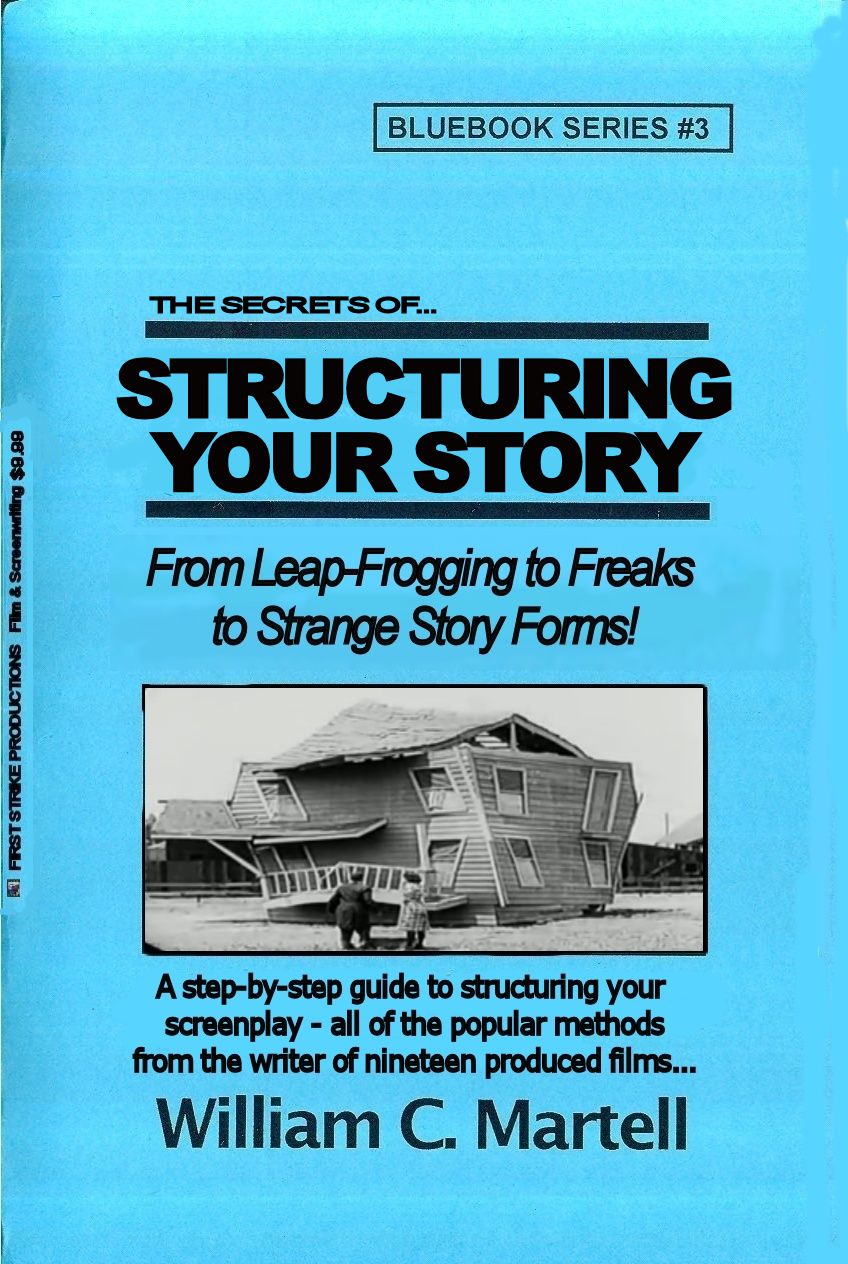
GOT STRUCTURE?!
*** STRUCTURING YOUR STORY ***
William Goldman says the most important single element of any screenplay is structure. It’s the skeleton under the flesh and blood of your story. Without it, you have a spineless, formless, mess... a slug! How do you make sure your structure is strong enough to support your story? How do you prevent your story from becoming a slug? This Blue Book explores different types of popular structures from the basic three act structure to more obscure methods like leap-frogging. We also look at structure as a verb as well as a noun, and techniques for structuring your story for maximum emotional impact. Most of the other books just look at *structure* and ignore the art of *structuring* your story. Techniques to make your story a page turner... instead of a slug!
Only $4.99 - Kindle Version

STORY: WELL TOLD!
*** STORY: WELL TOLD ***
This book takes you step-by-step through the construction of a story... and how to tell a story well, why Story always starts with character... but ISN'T character, Breaking Your Story, Irony, Planting Information, Evolving Story, Leaving No Dramatic Stone Unturned, The Three Greek Unities, The Importance Of Stakes, The Thematic Method, and how to create personal stories with blockbuster potential. Ready to tell a story?
Print version was 48 pages, Kindle version is over 85,000 words - 251 pages!
Only $4.99 - Kindle Version

HOW DO I DO THAT?
*** 101 SCREENWRITING ANSWERS ***
New to screenwriting? You probably have questions! How do I get an Agent? How do I write a phone conversation?
Do I need a Mentor? What’s does VO and OC and OS mean? What is proper screenplay format?
Should I use a pen name? Do I need to movie to Hollywood? What’s the difference between a
Producer and a Production Manager, and which should I sell my script to? How do I write a Text Message?
Should I Copyright or WGA register my script? Can I Direct or Star? How do I write an Improvised scene?
Overcoming Writer’s Block? How do I write a Sex Scene? And many many more! This book has the answers to
the 101 Most Asked Questions from new screenwriters! Plus a Glossary of terms so that you can sound like a pro!
Everything you need to know to begin writing your screenplay!
Only $4.99 - Kindle Version
NO KINDLE REQUIRED! Get the *free* app (any device, except your Mr. Coffee) on the order page on Amazon!

START STRONG!
*** HOOK 'EM IN TEN ***
Your story doesn't get a second chance to make a great first impression, and this book shows you a
bunch of techniques on how to do that. From the 12 Basic Ways To Begin Your Story, to the 3 Stars Of
Your First Scene (at least one must be present) to World Building, Title Crawls, Backstory, Starting
Late, Teasers and Pre Title Sequences, Establishing Theme & Motifs (using GODFATHER PART 2), Five Critical
Elements, Setting Up The Rest Of The Story (with GODFATHER), and much more! With hundreds of examples
ranging from Oscar winners to classic films like CASABLANCA to some of my produced films (because
I know exactly why I wrote the scripts that way). Biggest Blue Book yet!
Print version was 48 pages, Kindle version is over 100,000 words - 312 pages!
Only $4.99 - Kindle Version
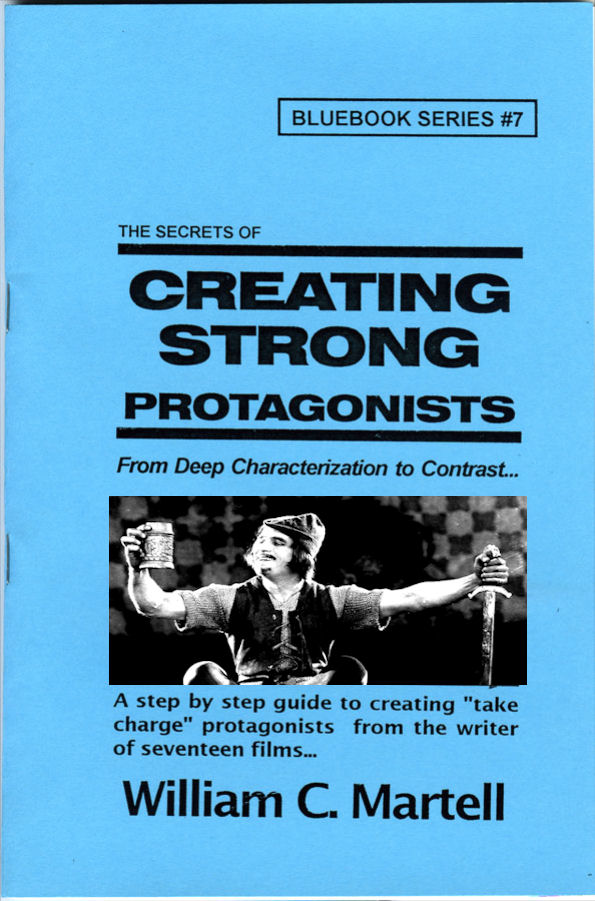
MOVIES ARE CHARACTERS!
*** CREATING STRONG PROTAGONISTS ***
Expanded version with more ways to create interesting protagonists! A step-by-step guide to creating "take charge" protagonists. Screenplays are about characters in conflict... characters in emotional turmoil... Strong three dimensional protagonists who can find solutions to their problems in 110 pages. But how do you create characters like this? How do you turn words into flesh and blood? Character issues, Knowing Who Is The Boss, Tapping into YOUR fears, The Naked Character, Pulp Friction, Man With A Plan, Character Arcs, Avoiding Cliche People, Deep Characterization, Problem Protagonists, 12 Ways To Create Likable Protagonists (even if they are criminals), Active vs. Reactive, The Third Dimension In Character, Relationships, Ensemble Scripts, and much, much more. Print version is 48 pages, Kindle version is once again around 205 pages!
ONLY $4.99 - Kindle Version
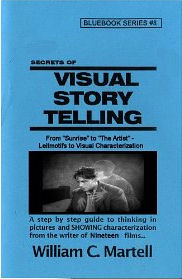
I WRITE PICTURES!
*** VISUAL STORYTELLING *** - For Kindle! (exclusive)
Show Don't Tell - but *how* do you do that? Here are techniques to tell stories visually! Using Oscar Winning Films and Oscar Nominated Films as our primary examples: from the first Best Picture Winner "Sunrise" (1927) to the Oscar Nominated "The Artist" (which takes place in 1927) with stops along the way Pixar's "Up" and Best Original Screenplay Winner "Breaking Away" (a small indie style drama - told visually) as well as "Witness" and other Oscar Winners as examples... plus RISE OF THE PLANET OF THE APES. Print version is 48 pages, Kindle version is over 200 pages!
ONLY $4.99 - Kindle Version
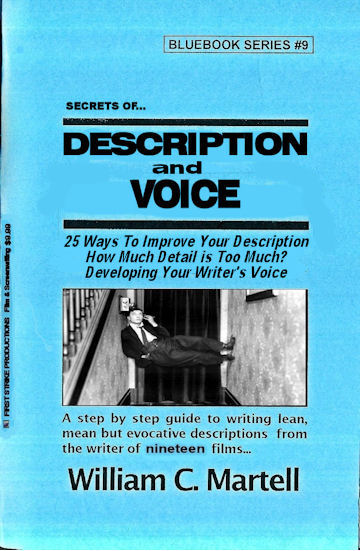
*** DESCRIPTION & VOICE ***
IS HALF OF YOUR STORY IN TROUBLE?
Most screenplays are about a 50/50 split between dialogue and description - which means your description is just as important as your dialogue. It just gets less press because the audience never sees it, the same reason why screenwriters get less press than movie stars. But your story will never get to the audience until readers and development executives read your script... so it is a very important factor. Until the movie is made the screenplay is the movie and must be just as exciting as the movie. So how do you make your screenplay exciting to read? Description is important in a novel as well, and the “audience” does read it... how do we write riveting description?
Only $4.99 Kindle version

PRO DIALOGUE TECHNIQUES!
*** DIALOGUE SECRETS ***
Expanded version with more ways to create interesting dialogue! How to remove bad dialogue (and what *is* bad dialogue), First Hand Dialogue, Awful Exposition, Realism, 50 Professional Dialogue Techniques you can use *today*, Subtext, Subtitles, Humor, Sizzling Banter, *Anti-Dialogue*, Speeches, and more. Tools you can use to make your dialogue sizzle! Special sections that use dialogue examples from movies as diverse as "Bringing Up Baby", "Psycho", "Double Indemnity", "Notorious", the Oscar nominated "You Can Count On Me", "His Girl Friday", and many more! Print version is 48 pages, Kindle version is over 175 pages!
Only $4.99 - Kindle Version
NO KINDLE REQUIRED! Get the *free* app (any device, except your Mr. Coffee) on the order page on Amazon!

WHAT IS A SCENE?
*** SCENE SECRETS ***
What is a scene and how many you will need? The difference between scenes and sluglines. Put your scenes on trial for their lives! Using "Jaws" we'll look at beats within a scene. Scene DNA. Creating set pieces and high concept scenes. A famous director talks about creating memorable scenes. 12 ways to create new scenes. Creating unexpected scenes. Use dramatic tension to supercharge your scenes. Plants and payoffs in scenes. Plus transitions and buttons and the all important "flow"... and more! Over 65,000 words! Print version was 48 pages, Kindle version is around 210 pages!
Only $4.99 - Kindle version
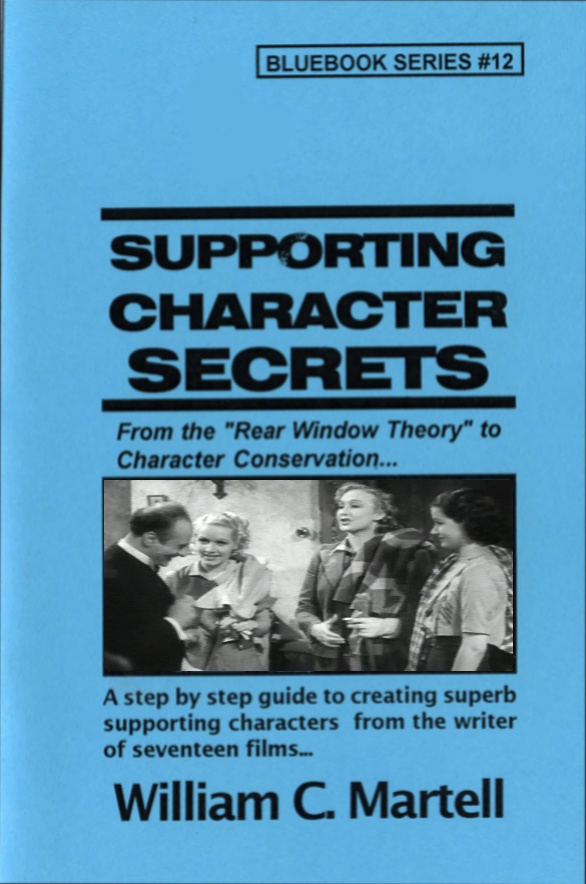
SUBPLOTS?
*** SUPPORTING CHARACTER SECRETS ***
Expanded version with more techniques to flesh out your Supporting Characters and make them individuals. Using the hit movie BRIDESMAIDS as well as other comedies like THE HANGOVER and TED and HIGH FIDELITY and
40 YEAR OLD VIRGIN and many other examples we look at ways to make your Supporting Characters come alive on the page.
Print version was 48 pages, Kindle version is around 170 pages!
ONLY $4.99 - Kindle version
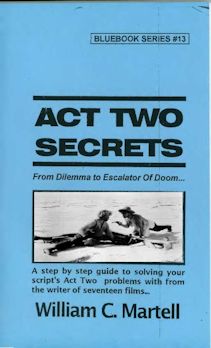
ACT TWO SOLUTIONS!
*** ACT TWO SECRETS ***
Expanded version with more techniques to help you through the desert of Act Two! Subjects Include: What Is Act Two? Inside Moves, The 2 Ps: Purpose & Pacing, The 4Ds: Dilemma, Denial, Drama and Decision, Momentum, the Two Act Twos, Subplot Prisms, Deadlines, Drive, Levels Of Conflict, Escalation, When Act Two Begins and When Act Two Ends, Scene Order, Bite Sized Pieces, Common Act Two Issues, Plot Devices For Act Two, and dozens of others. Over 67,000 words (that’s well over 200 pages) of tools and techniques to get you through the desert of Act Two alive!
Print version was 48 pages, Kindle version is well over 200 pages!
ONLY $4.99 - Kindle version

Can You Make It bigger?
***BLOCKBUSTERS (and BEACH READS) ***
Thinking about writing a big Disaster Movie? An Historical Epic? An Epic Adventure Film? Or maybe you like Gladiator Movies? This book looks at writing Blockbusters and those Big Fat Beach Read novels - anything epic! Usng movies like JAWS, POSEIDON ADVENTURE, LAWRENCE OF ARABIA, THE GUNS OF NAVARONE, and those MARVEL and FAST & FURIOUS flicks as examples. What *is* a Blockbuster? 107 years of Blockbuster history! Blockbuster Characters. Blockbuster Story Types! Why modern Blockbusters are soap operas! Social Issues in Blcokbusters? Big Emotions! Keeping All Of Those Characters Distinctive! How to avoid the Big problems found in Big Movies and books! More! If you are writing a Big Event Movie or a Big Fat Novel, there are tips and techniques to help you!
ONLY $4.99 - Kindle Version
NO KINDLE REQUIRED! Get the *free* app (any device, except your Mr. Coffee) on the order page on Amazon!
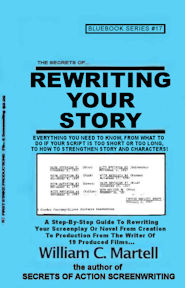
All About Rewrites!
*** REWRITES Blue Book! ***
When You Finish Your Screenplay Or Novel...
The Rewrites Begin!
The end is just the beginning! You’ve finished your story, but now the rewriting begins! This 405 page book
shows you how to rewrite your screenplay or novel to perfection. Everything from Character Consistency to
Shoeboxing to How To Give And Receive Notes to 15 Solutions If Your Script’s Too Long! and 15 Solutions
If Your Script’s Too Short! to Finding The Cause Of A Story Problem to Good Notes Vs. Bad Notes to Finding
Beta Readers to Avoiding Predictability to Learning To Be Objective About Your Work to Script Killer Notes and
Notes From Idiots to Production Rewrites and What The Page Colors Mean? and a Complete Rewrite Checklist!
The complete book on Rewriting Your Story!
Only $4.99 - Kindle Version

Want To Look Like An Expert?
*** RESEARCH & WORLD BUILDING BUILDING! ***
Using movie examples like TOP GUN, HUNT FOR RED OCTOBER, BLUE CRUSH, ADVENTURE LAND, several of my produced films,
JOHN WICK, the novels of Donald E. Westlake and Thomas B. Dewey, SPY KIDS, the LORD OF THE RINGS movies, SOYLENT GREEN
(which takes place in the far off future of 2022), and many others we will look at researching stories and creating worlds.
The 8 Types Of Research, the 10 Types Of Information To Look For, 12 Important Elements Of World Building. Plus chapters on How
To Rob A Bank and Commit Murder And Get Away With It for those of you interested in crime fiction, and Researching The Future
for those writing science fiction, and Levels Of Reality if you are writing about a version of the real world.
Only $4.99 - Kindle Version

All About LOGLINES, TREATMENTS, and PITCHING!
*** LOGLINES, TREATMENTS, and PITCHING! ***
You have written a brilliant 110 page screenplay, but how do you get anyone to read it? You need to distill
it down into some form of verbal moonshine or story rocket fuel that will ignite that bored development executive
or manager or agent and get them to request your screenplay. But how do you shrink those 110 pages into a 25
word logline or a 2 minute elevator pitch or a one page synopsis or a short paragraph? This 100,000 word book
shows you how! Everything you need to know! From common logline mistakes (and how to solve them) to how
your pitch can reveal story problems to the 4 types of pitches!
ONLY $4.99! - Kindle version.
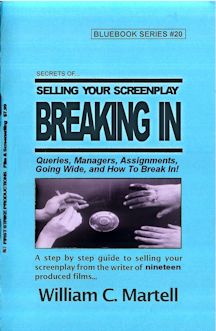
READY TO BREAK IN?
*** BREAKING IN BLUE BOOK ***
Should really be called the BUSINESS BLUE BOOK because it covers almost everything you will need to
know for your screenwriting career: from thinking like a producer and learning to speak their language,
to query letters and finding a manager or agent, to making connections (at home and in Hollywood) and
networking, to the different kinds of meetings you are will have at Studios, to the difference between
a producer and a studio, to landing an assignment at that meeting and what is required of you when you
are working under contract, to contracts and options and lawyers and... when to run from a deal!
Information you can use *now* to move your career forward! It's all here in the Biggest Blue Book yet!
Only $4.99 - Kindle version.

STORY IN ACTION SERIES!

THE MISSION IMPOSSIBLE MOVIES
NEW: Updates On Films 7 & 8 Casting!
The First Six Movies analyzed! All of the mission tapes, all of the “that’s impossible!” set pieces and stunts, the cons and capers - and how these scenes work, the twists and double crosses, the tension and suspense (and how to generate it), the concept of each film as a stand alone with a different director calling the shots (broken in the sixth film), the gadgets, the masks, the stories, the co-stars and team members (one team member has been in every film), the stunts Tom Cruise actually did (and the ones he didn’t), and so much more! Over 120,000 words of fun info!
THE MISSION IMPOSSIBLE MOVIES - 347 Pages -
Only $3.99 ! - Kindle Version

*** THE BOURNE MOVIES
All five "Bourne" movies (including "Legacy" and it's potential sequels) - what are the techniques used to keep the characters and scenes exciting and involving? Reinventing the thriller genre...
or following the "formula"? Five films - each with an interesting experiment! A detailed analysis of each
of the films, the way these thrillers work... as well as a complete list of box office and critical
statistics for each film. This book is great for writers, directors, and just fans of the series.
Only $3.99 - Kindle version
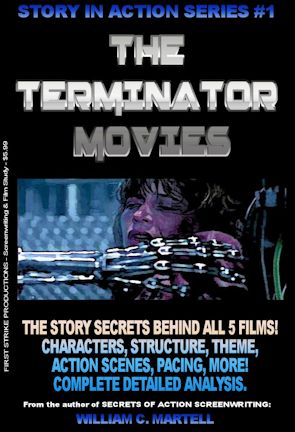
Over 240 pages!
*** THE TERMINATOR MOVIES ***
He's back! The release of "Terminator: Dark Fate" is set to begin a new trilogy in
the Terminator story... 35 years after the first film was released. What draws us to these films about
a cybernetic organism from the future sent back in time? Why is there a new proposed trilogy every few
years? This book looks at all five Terminator movies from a story standpoint - what makes them work
(or not)? What are the techniques used to keep the characters and scenes exciting and involving? How
about those secret story details you may not have noticed? Containing a detailed analysis of each of
the five films so far, this book delves into the way these stories work... as well as a complete list of
box office and critical statistics for each film. This book is great for writers, directors, and just
fans of the series.
ONLY $3.99 - Kindle Version
HITCHCOCK FOR WRITERS!
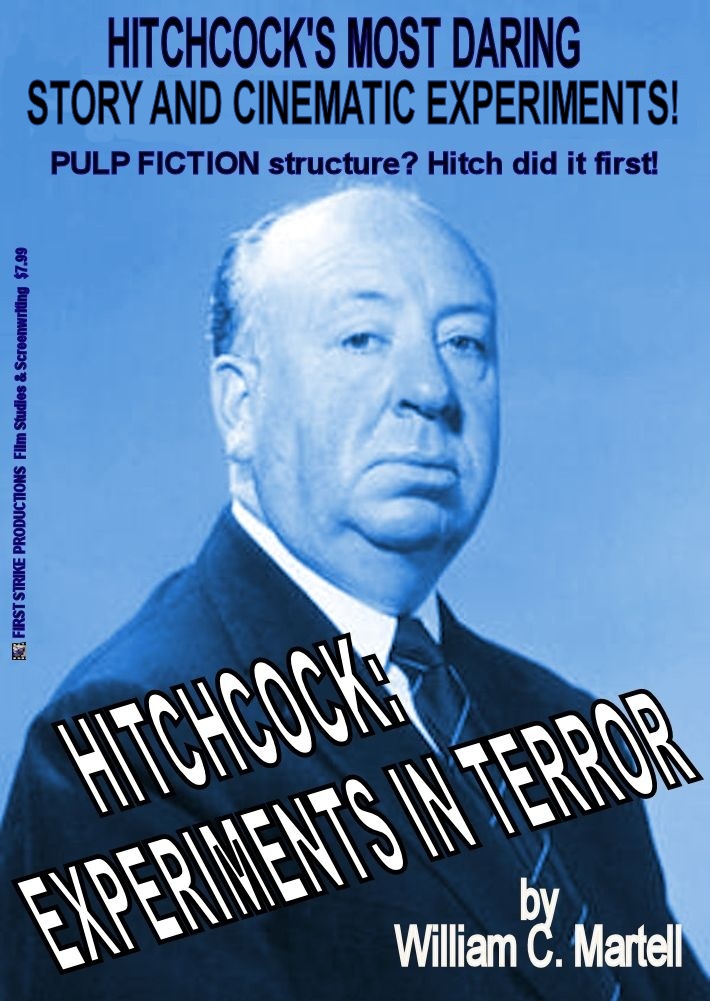
Strange Structures!
*** HITCHCOCK: EXPERIMENTS IN TERROR! ***
Contained Thrillers like "Buried"? Serial Protagonists like "Place Beyond The Pines"? Multiple Connecting Stories like "Pulp Fiction"? Same Story Multiple Times like "Run, Lola, Run"?
HITCHCOCK DID IT FIRST!
This book focuses on 18 of Hitchcock's 52 films with wild cinema and story experiments which paved the way for modern films. Almost one hundred different experiments that you may think are recent cinema or story inventions... but some date back to Hitchcock's *silent* films! We'll examine these experiments and how they work. Great for film makers, screenwriters, film fans, producers and directors.
Only $5.99 - Kindle Version
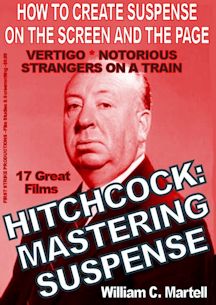
LEARN SUSPENSE FROM THE MASTER!
*** HITCHCOCK: MASTERING SUSPENSE ***
Alfred Hitchcock, who directed 52 movies, was known as the *Master Of Suspense*; but what exactly is suspense and how can *we* master it? How does suspense work? How can *we* create “Hitchcockian” suspense scenes in our screenplays, novels, stories and films?
This book uses seventeen of Hitchcock’s films to show the difference between suspense and surprise, how to use “focus objects” to create suspense, the 20 iconic suspense scenes and situations, how plot twists work, using secrets for suspense, how to use Dread (the cousin of suspense) in horror stories, and dozens of other amazing storytelling lessons. From classics like “Strangers On A Train” and “The Birds” and “Vertigo” and “To Catch A Thief” to older films from the British period like “The 39 Steps” and “The Man Who Knew Too Much” to his hits from the silent era like “The Lodger” (about Jack The Ripper), we’ll look at all of the techniques to create suspense!
Only $5.99 - Kindle Version
FICTION
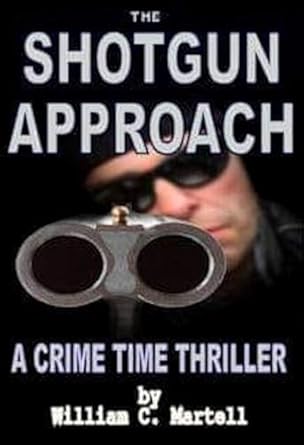
Featuring Shelly Steele !
*** THE SHOTGUN APPROACH ***
A Pop Star is murdered on the VIP floor of a luxury hotel by a shotgun blast to the face... completely ruining an original piece of art
on the wall behind him. Violent SFPD Homicide Inspector Shelly Steele must find the murderer... without killing anyone in the process.
That won't be easy! A locked room, A handful of clues. A chase and shootout on the hotel's fire stairs.
Who is the killer? His ex-Partner? His ex-Wife? His ex-Record Label Owner?
THE SHOTGUN APPROACH 105 pgs!
ONLY $.99 - Kindle Version
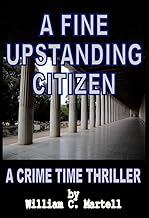
Featuring Smart & Final !
*** A FINE UPSTANDING CITIZEN ***
25 years ago Senator Milano killed a man. Now he's one of a dozen suspects in an information leak.
Being interrogated in the executive boardroom on the 30th floor of an office building...
The informant will not be leaving by the elevator. Can he solve the crime before they discover his secret?
Fnd the rat before the trap springs on him?
A FINE UPSTANDING CITIZEN (CRIME TIME THRILLER) 86 pgs!
ONLY $.99 - Kindle Version

Crime Time Thriller !
*** FOLLOWED HOME ***
Bowden knew the best place to find a victim is somewhere they feel safe. Diane Taylor would be his next victim...
It began with a car jacking at an upscale grocery store, but fresh out of prison Bowden decided to take everything -
forcing Diane to drive him her her luxury home. Trapped in her SUV with a violent man, can she find a way to turn the tables on him and survive?
FOLLOWED HOME (CRIME TIME THRILLER)
ONLY $.99 - Kindle Version

Featuring Smart & Final !
*** PRIME RATE ***
Chuck Skinner brought his father's failing butcher shop back into the black with the help of modern day cattle rustlers. Nice story if it ends there...
But now the head of the MaryAnn Mob of cattle rustlers suspects him of cooking his books, and has brought in an "accountant"
nicknamed Smart & Final... to hold him accountable. Can Chuck talk his way out of this?
PRIME RATE (CRIME TIME THRILLER)
ONLY $.99 - Kindle Version
MITCH ROBERTSON MYSTERIES

Mitch Robertson #1
*** THROUGH THE RINGER ***
Screenwriter Mitch Robertson just wants to sell a script, but ends up solving the mystery of a whiz kid writer whose new script stinks.
From an upscale vodka bar in Beverly Hills to the Writer's Guild Library to an old mansion in the woodsy Brentwood district, Mitch follows
the clues to uncover the secret of the hot new writer who has suddenly turned cold.
THROUGH THE RINGER
ONLY $.99 - Kindle Version
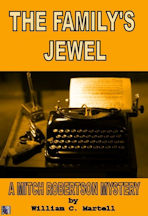
Mitch Robertson #2
*** THE FAMILY'S JEWEL ***
"The Presidential Suite of the Hollywood Hoover Hotel looked like a bloody battlefield: bodies everywhere, furniture broken, red liquid dripping from the walls, dead soldiers littering the elegant Berber rug as clouds of smoke overhead bounced between two air conditioning vents.
Mitch Robertson stepped over the body of an ex-child star turned sex tape star turned pop star and entered the room, spotted a gun on the floor and picked it up... careful not to spill his coffee with three pumps of mocha syrup from Penny’s Coffee Shop. That coffee was gold, the only thing keeping him going in this dazed state of wakefulness. The gun felt light. Holding it, he saw the silhouette of an 80s action star sitting sideways on a tipped over chair. Motionless. Was he dead? Mitch was still hung over from the Awards Party the night before, and wondered whether this was all some sort of crazy nightmare that he would wake up from... but when he tripped over the brown legs of a bottomless Superhero, flaccid junk encased in a condom but still wearing his mask, and hit the edge of the sofa, gun skittering and coffee spilling, he realized that it was all very real. What the hell had happened here?"
Short Novel. Only 99 cents! - Kindle Version
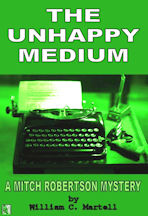
Mitch Robertson #3
***
THE UNHAPPY MEDIUM ***
When Warren Moultie, the "Psychic To The Stars", private files, with dirt on everyone in Hollywood, are stolen, Mitch must find them and the
thief before the blackmail begins! But when studios and movie stars and pop music stars and TV stars begin receiving demands for millions
typed by an ancient typewriter on cheap paper, the entire Entertainment Industry is depending on him. Who stole the files? The Psychic? His wife?
His mistress? One of his famous clients?
Novella. Only 99 cents! - Kindle Version


Use your creative energy to focus on the content; let Final Draft take care of the style. Final Draft is the number-one selling application specifically designed for writing movie scripts, television episodics and stage plays. Its ease-of-use and time-saving features have attracted writers for almost two decades positioning Final Draft as the Professional Screenwriters Choice. Final Draft power users include Academy, Emmy and BAFTA award winning writers like Oliver Stone, Tom Hanks, Alan Ball, J.J. Abrams, James Cameron and more.
* * * Buy It!
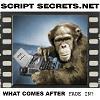
|

